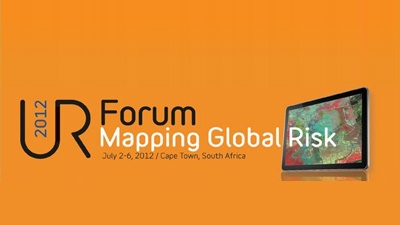CAPE TOWN, July 4, 2012—For years in the northern Namibian town of Oshakati, floods crippled local industry and forced people from their homes. It wasn’t until engineers mapped the area using geospatial flood models—based on maps that use various sources of data to show flood paths and depth—that a road was identified as the main culprit. Rising two meters above the rest of the land, the road acted as a dam forcing water back into the business district.
Globally, floods account for one-third of losses caused by natural disasters. In 2010 alone, floods were the single most frequent disaster, impacting 178 million people. Managing these floods, before they impact communities, according to experts, is key to lowering the economic and social costs that affect governments and their citizens.
Rural farmers receive weather forecasts by phone
During sessions July 3 at the 2012 Understanding Risk Forum in Cape Town, South Africa, disaster risk practitioners, engineers and other scientists outlined a series of tools used to manage the risks associated with floods and droughts. Among them: open data, early warning systems, GIS mapping, SMS technology, even social safety nets.
In Ethiopia, the World Food Program’s LEAP program, a tool that can calculate crop yield early in the country’s dry season, is helping humanitarian organizations forecast the needs of communities in drought-prone areas. Along with a government-run social safety net program, which provides credit and insurance for work, farmers are able to predict bad weather, pay for losses if bad weather occurs and access financial resources.
According to the WFP’s Niels Balzer, if there’s a drought, farmers get an insurance payout. If the season goes well, they get access to credit which allows them to purchase additional seeds and equipment.
In Kenya, the Intergovernmental Authority on Development (IGAD) is using SMS technology to alert Masai farmers to upcoming bad weather. Funded by the World Bank through its Global Facility for Disaster Reduction and Recovery, or GFDRR, the group is using the same technology to put phones in the hands of rural residents so they can alert humanitarian organizations of their location and need during disasters.
According to Balzer, drought has a direct and immediate impact, but it also has long-term effects on households and can lead to long-term poverty. The affects range from loss of income and missed school to damaged infrastructure, displacement, hunger and death.
Mapping flood paths
In an effort to better predict disasters before they happen, experts are turning to open data for evidence-based analysis, and to mapping for planning purposes and to show where disasters may have the greatest impact.
In the Caribbean, the GeoNode platform, developed by scientists at the University of the West Indies, provides data on coastline roads, soil type, rainfall and land areas. Designers have opened the data to the general public to help people make better decisions in manage disasters risks and vulnerability to climate change.
“If you want to find out the flood risk in a community, you can use the platform,” said Dr. Jacob Opadeyi, a professor of Geomatics Engineering and Land Management at the University. “The benefit is to increase disaster risk awareness so you don’t have to wait for anyone to tell you. If you want to buy a piece of land, you can find out if it’s in a flood zone.”
In the Netherlands, engineers are testing the 3Di tool, which allows experts to animate flood zones to show where floods might cause the most damage. The tool uses high-resolution images to get more accurate information and is an upgrade from previously-used two-dimensional technology.
According to Hessel Winsemius of the Netherlands Environmental Assessment agency Deltares, users can see in detail which homes in an area would be damaged; this can ultimately inform where homes should be built away from flood-prone zones.
“We build schools on seismic faults without applying the right seismic-resilient standards; we build water treatment facilities in riverbeds, houses in cyclone paths; and cities in flood plains,” said Jonathan Kamkwalala, Water Resources manager for the World Bank’s Africa Region. “Because we are building in hazard prone areas and at the same time failing to apply appropriate building standards, we are creating new risks every day.”
While disaster managers agree that there is no way to eliminate risks associated with natural disasters, planning for them and avoiding the negative impacts can be managed.
As former World Bank Group President Robert B. Zoellick has said, “Globally, we need to better understand how and when we are vulnerable to risks and how we can better manage them.”

